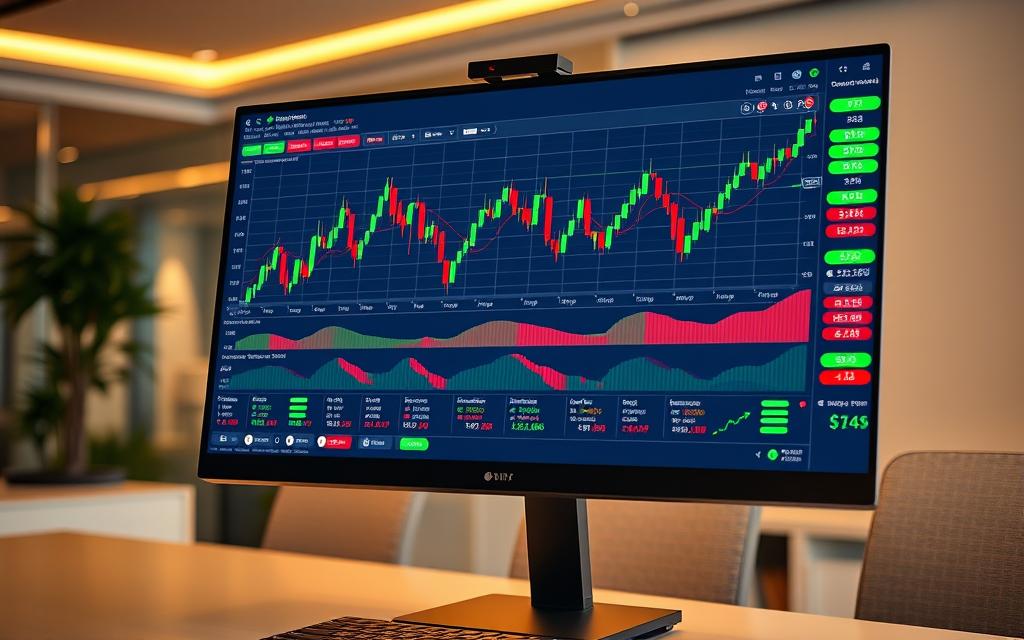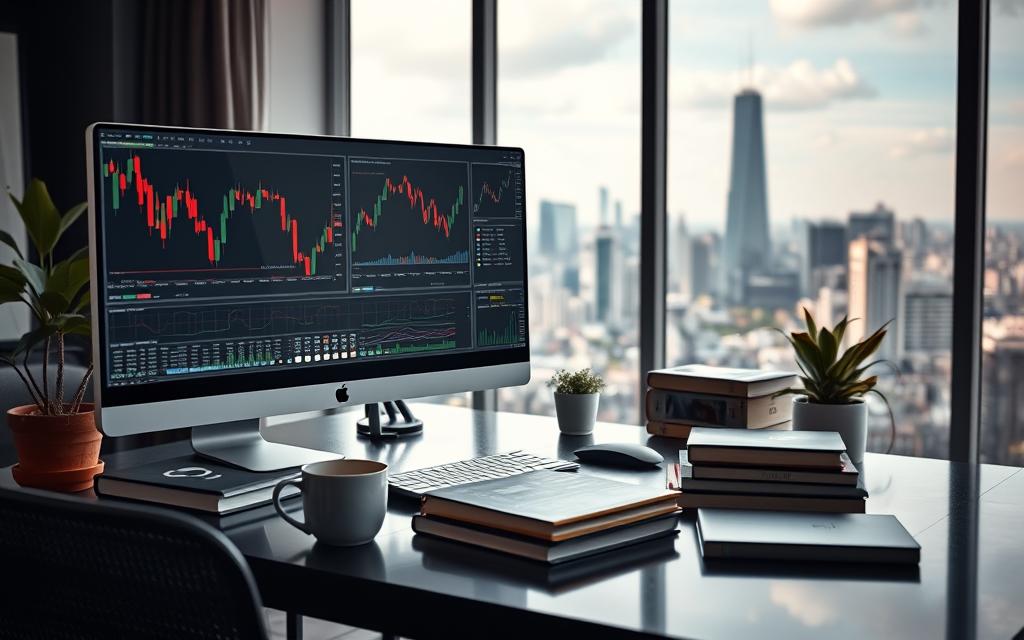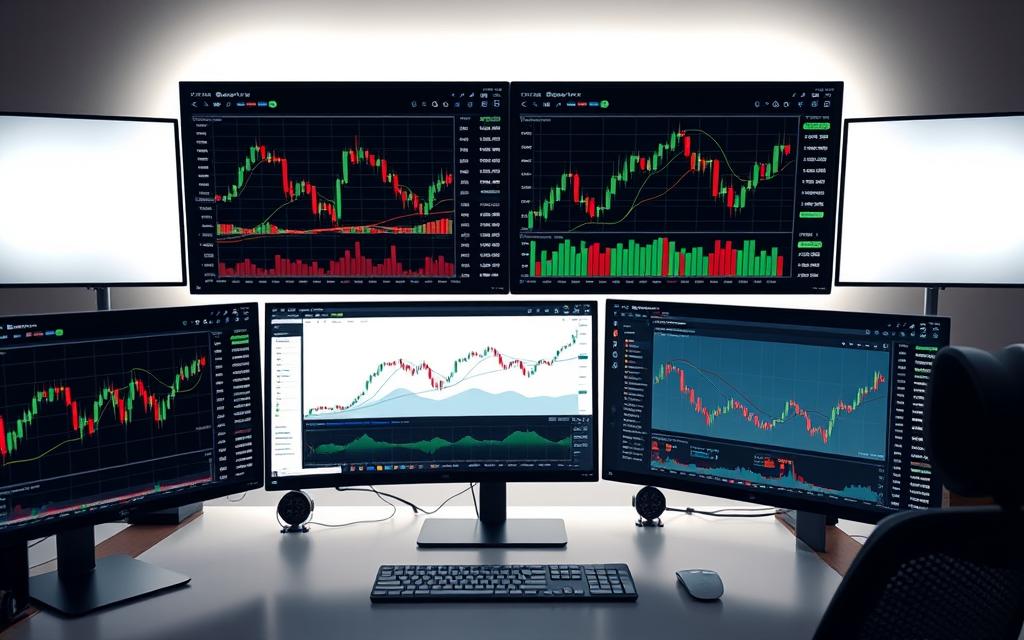The forex market trades over $7 trillion daily, making it huge and very liquid. If you’re new to forex trading, it’s key to learn the basics. You need to know how the market works, its benefits and risks, and the tools you’ll use and you can start with this forex trading for beginners guide.
For beginners, having a detailed guide to forex trading is vital. It should cover everything from currency pairs to advanced strategies. This guide will equip you with the knowledge and tools to do well in the forex market.
Understanding the Basics of Forex Trading
Forex trading is about exchanging one currency for another at a set price. The goal is to make money from changes in exchange rates. To start, you need to know the basics, like the best strategies for beginners and how to begin trading.
The forex market is huge, with over $6 trillion in daily transactions. It’s the largest financial market worldwide. To start trading, it’s important to learn key terms.
Leverage can be as high as 50:1 on major currency pairs. A pip is the smallest price change in forex. Prices have a bid and ask, and the spread is the difference between them.
To find the best strategies, you must understand different markets and the role of market makers. Learning about the forex market and its terms helps beginners trade confidently. With the right knowledge, anyone can succeed in forex trading.
Some key points for beginners include:
- Understanding leverage and its impact on trading
- Learning about different types of orders, such as market orders and limit orders
- Familiarizing yourself with trading platforms and tools
- Developing a trading plan and sticking to it
By following these steps and learning the basics, beginners can succeed. They can develop the best forex trading strategies for their needs.
Getting Started in the Currency Markets
The forex market is the most traded globally, making it easy for beginners to start. Many online brokers have easy-to-use platforms and educational tools. These include forex trading tips for beginners and forex trading tutorials for beginners. They help new traders understand the markets and make smart choices.
First, you need to know how to set up a trading account and pick a broker. Here are some important points to consider:
- Find a broker that offers a demo account to practice trading without risk
- Choose a broker with a simple platform and good customer support
- Make sure the leverage ratio fits your risk management plan
After setting up your account, you can explore forex trading. The forex market trades about $850 million every second. It offers many chances for traders. By following forex trading tips for beginners and forex trading tutorials for beginners, you can build a strong base for success.

It’s wise to start small, with mini or micro accounts, to manage risk. Using strategies like stop-loss orders and diversifying your investments can help. This way, you can reduce risk and increase your chances of success.
When you’re ready to start trading with real money, it’s important to have a trading strategy in place. This could involve technical analysis, fundamental analysis, or a combination of both. Technical analysis involves studying price charts and indicators to predict future price movements, while fundamental analysis involves analyzing economic data and news events that could affect currency prices.
To improve your chances of success in the currency markets, it’s important to have a trading plan and stick to it. This includes setting clear goals, using risk management techniques, and continuously educating yourself about the forex market.
It’s also important to manage your risk by setting stop-loss orders to limit potential losses and sticking to a risk management plan. Remember that forex trading can be highly volatile and risky, so it’s important to only trade with money you can afford to lose.
Essential Tools and Platforms for Forex Trading
Forex trading needs the right tools and platforms for success. A beginner course is a good start, but you need more than knowledge. The forex market is huge, with over $6 trillion traded daily. With the right tools, you can join this massive market.
First, pick a trading platform that fits your needs. MT4, MT5, and OctaTrader are popular choices. They offer many features to help you trade well. Don’t forget about risk management tools like stop-loss orders and position sizing.

You’ll also need technical indicators, charting software, and market analysis tools. These help you make smart trading choices and stay on top of the market. With the right tools and platforms, you’re ready to succeed in forex. This is true whether you’re starting with a beginner course or diving into forex on your own.
Must-Have Trading Tools
- Technical indicators, such as moving averages and RSI
- Charting software, such as candlestick charts and line charts
- Market analysis tools, such as news feeds and economic calendars
Using these essential tools and platforms, you can build a strong trading setup. Always remember to manage your risk well. Never risk more than 1-2% of your total trading capital on any single trade.
Forex Trading for Beginners: Core Strategies and Techniques
For beginners in forex trading, knowing key strategies is vital. A good beginner-friendly forex trading platform offers the tools needed to start. Technical analysis is a key strategy, using charts and indicators to forecast price changes.
Risk management is also crucial. This includes setting stop-loss orders, spreading trades, and controlling leverage. By combining technical and fundamental analysis, traders can make smart choices and reduce losses. For instance, a trader can use a beginner-friendly forex trading platform to set a stop-loss order to limit losses if a trade fails.
Popular strategies for forex trading for beginners include trend following, range trading, and breakout trading. These methods can be paired with technical indicators like moving averages and candlestick patterns. This helps identify trading chances. By using a beginner-friendly forex trading platform and these strategies, beginners can boost their success in the forex market.

Success in forex trading for beginners depends on staying informed, being disciplined, and adapting to market changes. By employing a beginner-friendly forex trading platform and sticking to core strategies, traders can confidently navigate the forex market and reach their goals.
Understanding Currency Pairs and Market Analysis
Currency pairs are key in forex trading. Knowing how they work is crucial for smart trading choices. The value of a currency in a pair changes based on the exchange rate. Forex trading strategies often look at these changes to guess future prices.
Big currency pairs like EUR/USD, USD/JPY, and GBP/USD are very popular. They have high liquidity. For most pairs, a pip is the fourth decimal place. But for JPY pairs, it’s the second decimal. Forex trading tips stress the need to know each pair’s traits, like how volatile they are.
To craft good forex trading strategies, traders must also think about fundamental analysis. This includes economic indicators, news, and market mood. Mixing technical and fundamental analysis helps traders understand the market better. By following forex trading tips and keeping up with market analysis, traders can boost their success in the forex market.

Forex trading is a complex and fast-paced world, where currencies are bought and sold in pairs. Understanding how these currency pairs work and how to analyze the market can be the key to success in the forex market.
Currency pairs are pairs of currencies that are traded against each other in the forex market. The value of a currency pair is determined by the exchange rate between the two currencies. For example, the EUR/USD currency pair represents the value of the Euro against the US Dollar. When trading forex, traders are essentially buying one currency while selling another currency at the same time.
Market analysis is crucial in forex trading, as it helps traders make informed decisions about when to enter or exit trades. There are two main types of analysis that traders use: technical analysis and fundamental analysis.
Technical analysis involves analyzing past market data, such as price charts and trading volumes, to predict future price movements. Traders use technical indicators and chart patterns to identify trends and patterns in the market that can help them make trading decisions.
Fundamental analysis, on the other hand, involves analyzing economic data and news events to predict how currencies will move in the market. Traders look at factors such as interest rates, inflation, and political stability to determine the strength or weakness of a currency.
When analyzing currency pairs, traders look at factors such as market trends, economic data releases, and geopolitical events that can impact the value of a currency. By understanding how these factors influence the market, traders can make more accurate predictions about future price movements.
Overall, understanding currency pairs and market analysis is essential for success in the forex market. By staying informed and using various analytical tools, traders can make better trading decisions and increase their chances of profitability in the highly competitive world of forex trading.
Risk Management in Forex Trading
Effective risk management is key to success in forex trading. It involves using techniques like stop-loss orders and position sizing. A forex trading course offers valuable insights and strategies for managing risk.
Experts say risk management is vital in forex trading. It’s important to understand risk-reward ratios and how to use them. This helps make informed trading decisions.

The “One-Percent Rule” is a key concept in risk management. It advises traders to risk no more than 1% of their account on a single trade. For a $10,000 account, this means a maximum risk of $100 per trade. Traders can also use moving averages to set stop-loss and take-profit points. Key averages include the 5-, 9-, 20-, 50-, 100-, and 200-day averages.
Some essential tips for risk management in forex trading include:
- Diversification across industry sectors, market capitalization, and geographic regions to manage risk
- Utilizing leverage with caution, starting with low leverage ratios of 5:1 or 10:1
- Regular calculation of Forex risk percentage across all positions
- Continuous adaptation and education to stay up-to-date with market trends and strategies
Aforex trading course can offer valuable insights and strategies for managing risk. By following these tips and staying informed, traders can develop a effective risk management strategy. This can lead to success in the forex market.
Creating Your First Trading Plan
Creating a trading plan is key to success in Forex trading. It should have realistic goals, risk tolerance, and strategies. Research shows that making a plan involves 10 important steps. It’s also vital to stay disciplined and consistent in trading.
A forex trading platform and forex trading software can aid in planning. It’s important to set realistic return expectations and understand potential losses. Traders should also decide how much of their portfolio to risk with each trade.
Some important parts of a trading plan include:
- Assessing risk tolerance, including financial situation, personal investment goals, and experience with financial markets
- Setting realistic goals and expectations
- Developing entry and exit strategies
- Position sizing and money management techniques

By following these steps and using a reliable forex trading platform and forex trading software, traders can make a detailed plan. This plan helps them reach their goals and manage risks well.
Common Mistakes to Avoid in Forex Trading
Forex trading for beginners can be tough, with many pitfalls to steer clear of. One big mistake is emotional trading, which can cause impulsive decisions and big losses. Discipline and patience are key, helping traders make smart choices and avoid emotional decisions.
Another important part of forex trading basics is managing risk. Traders should limit their risk to no more than 1% of their total capital to avoid big losses from one trade. Using stop-loss orders can cut potential losses by up to 60%. It’s also vital to track significant news events and economic data releases, as they can change currency values and affect trading decisions.
To avoid common mistakes in forex trading, beginners should focus on education and strategy formulation. This means learning about technical indicators, fundamental analysis, and risk management techniques. By doing this, traders can gain a solid grasp of the forex market and make informed decisions to succeed in forex trading for beginners.
Some key mistakes to avoid in forex trading include:
- Overtrading, which can lead to capital depletion and significant losses
- Ignoring risk management strategies, such as stop-loss orders and position sizing
- Failing to track significant news events and economic data releases
By knowing these common mistakes and taking steps to avoid them, forex trading beginners can boost their success chances and build a strong foundation in forex trading basics.

Forex trading can be a lucrative venture if done correctly, but there are common mistakes that many beginners make that can result in significant losses. In this blog post, we will outline some of the most common mistakes to avoid in forex trading to help you maximize your profits and minimize your risks.
1. Overtrading: One of the most common mistakes that beginners make in forex trading is overtrading. This can happen when traders get caught up in the excitement of the market and make too many trades, often based on emotion rather than solid analysis. Overtrading can lead to significant losses due to increased transaction costs and a lack of focus on quality trades.
2. Ignoring risk management: Another common mistake that beginners make in forex trading is ignoring risk management. It is crucial to have a solid risk management strategy in place to protect your capital and minimize your losses. This includes setting stop-loss orders, diversifying your trades, and adhering to proper position sizing.
3. Chasing losses: One of the worst mistakes a trader can make is chasing losses. This happens when a trader tries to recover from a losing trade by increasing their risk exposure in subsequent trades. Chasing losses can lead to even bigger losses and wipe out your trading account.
4. Poor trading plan: A lack of a solid trading plan is another common mistake in forex trading. A trading plan outlines your trading goals, strategies, and risk management rules. Without a trading plan, you are more likely to make impulsive decisions based on emotion rather than logic.
5. Not doing enough research: Many beginners make the mistake of not doing enough research before placing trades. It is crucial to analyze market trends, economic indicators, and news events that can impact currency prices. Without proper research, you are essentially gambling with your money.
6. Trading without a strategy: Trading without a solid strategy is another common mistake that beginners make in forex trading. A trading strategy helps you identify profitable opportunities and execute trades with a clear plan in mind. Without a strategy, you are essentially trading blindly and relying on luck.
By avoiding these common mistakes in forex trading, you can increase your chances of success in the market. Remember to trade with discipline, adhere to risk management principles, and always have a solid trading plan in place. With dedication and proper education, you can become a successful forex trader.
Building a Sustainable Trading Career
Forex trading can be very rewarding, but it needs a long-term view. Successful traders know the value of patience, discipline, and keeping up with market news. By using forex trading strategies for beginners, new traders can lay a strong foundation for their career.

To have a lasting trading career, understanding the markets well is key. include setting realistic goals, making a trading plan, and always learning and getting better. Some important tips are:
- Start with a solid understanding of the basics of forex trading
- Develop a trading plan and stick to it
- Stay up-to-date with market news and analysis
By following these tips and staying dedicated to learning and getting better, traders can build a lasting trading career. Remember, forex trading strategies for beginners are just the beginning. It’s up to each trader to grow their skills and knowledge to succeed in the markets.
Your Next Steps in Forex Trading
As you finish this forex trading for beginners guide, it’s time to move forward. The beginner-friendly forex trading tips you’ve learned are a great start. They will help you begin your journey in the currency markets.
The Forex market is open 24/7, 5 days a week. It offers trading chances all over the world. Pairs like EUR/USD are very popular, thanks to their high liquidity. Beginners often use Trend Trading, Range Trading, and Breakout Trading to make money.
Starting your Forex trading journey? Set realistic goals and stick to your trading style. Use tools like Stop-Loss and Take-Profit orders to manage risk. Always analyze the market and keep a trading record. Be careful of high volatility and avoid big mistakes like over-leveraging.
Now you have the knowledge to start your forex trading for beginners journey. Look for good online brokers and sign up for a demo account. Practice your strategies without risk. Remember, patience, discipline, and a love for learning are key to success in Forex trading.

Forex Trading for Beginners
Forex trading, or foreign exchange trading, involves buying and selling currencies to profit from their fluctuating values. It’s the largest and most liquid financial market in the world, with a daily trading volume exceeding $6 trillion. For beginners, stepping into this dynamic market can be daunting, but with the right knowledge and strategies, you can navigate it effectively. Here’s a comprehensive guide to help you start your Forex journey.
1. Understanding Forex Basics
What is Forex?
- Definition: Forex is the exchange of one currency for another in the global marketplace.
- Participants: Central banks, financial institutions, corporations, retail traders.
Key Concepts:
- Currency Pairs: Forex is traded in pairs (e.g., EUR/USD). The first currency is the base, and the second is the quote.
- Bid and Ask Price: The bid is what buyers are willing to pay, while the ask is the price sellers are asking for.
- Pip: The smallest price movement, often the fourth decimal place (e.g., 0.0001).
- Leverage: Allows traders to control a larger position with a smaller amount of capital. Be cautious as it increases both potential profit and risk.
2. Why Trade Forex?
- Accessibility: Open 24 hours a day, five days a week.
- Liquidity: High trading volumes ensure quick execution of trades.
- Low Barriers to Entry: Start with small capital using micro or mini accounts.
- Diverse Strategies: Suitable for day traders, swing traders, and long-term investors.
3. How to Get Started with Forex Trading
Step 1: Learn the Basics
- Take online courses or read beginner-friendly books.
- Familiarize yourself with trading terminology and market dynamics.
Step 2: Choose a Reliable Broker
- Look for regulated brokers in your region.
- Compare fees, trading platforms, and customer support.
- Opt for a broker offering a demo account.
Step 3: Use a Demo Account
- Practice trading without risking real money.
- Understand how to use the trading platform and test strategies.
Step 4: Develop a Trading Plan
- Set Goals: Define your profit targets and risk tolerance.
- Risk Management: Never risk more than 1-2% of your trading capital on a single trade.
- Strategy: Choose a method that suits your personality, such as scalping, day trading, or swing trading.
4. Common Forex Trading Strategies
Trend Trading
- Identifying and trading in the direction of the prevailing market trend.
- Use indicators like moving averages or trendlines.
Range Trading
- Focusing on price ranges where the currency oscillates between support and resistance levels.
Breakout Trading
- Entering a trade when the price breaks out of a defined range or chart pattern.
Fundamental Analysis
- Evaluating economic indicators like GDP, interest rates, and employment data.
Technical Analysis
- Using charts and indicators (RSI, MACD, Bollinger Bands) to predict price movements.
5. Tools and Resources for Beginners
- Trading Platforms: MetaTrader 4 (MT4), MetaTrader 5 (MT5), or broker-specific platforms.
- Economic Calendars: Track major economic events affecting currency markets.
- News Sources: Bloomberg, Reuters, or Forex Factory for market updates.
6. Risks Involved in Forex Trading
Market Volatility
- Currency values can change rapidly, leading to significant losses.
Leverage Risks
- While leverage amplifies potential profits, it also magnifies losses.
Emotional Trading
- Avoid impulsive decisions driven by fear or greed.
Lack of Knowledge
- Jumping into Forex without proper education often leads to losses.
7. Tips for Success
- Educate Yourself Continuously: Forex is ever-changing; stay updated with trends and strategies.
- Start Small: Begin with a small investment and gradually increase as you gain confidence.
- Keep a Trading Journal: Track your trades to analyze what works and what doesn’t.
- Be Disciplined: Stick to your trading plan and risk management rules.
- Avoid Overtrading: Don’t trade out of boredom or frustration.
Is Forex Right for You?
Forex trading is not for everyone. It requires time, effort, and the ability to handle risks. If you enjoy analyzing markets, can manage stress, and are willing to learn, Forex can be a rewarding venture.
Forex trading offers exciting opportunities, but it’s crucial to approach it with the right mindset, tools, and knowledge. For beginners, patience and discipline are key to long-term success. Always remember, Forex is a journey, not a sprint. Start slow, keep learning, and adapt as you grow.
Key Takeaways
- Forex trading is a global market with an average daily trading volume exceeding $7 trillion.
- Understanding forex basics for beginners is crucial for success in the market.
- Forex trading for beginners requires knowledge of the market, benefits, and risks involved.
- Essential tools and platforms are needed to succeed in forex trading.
- A comprehensive guide to forex trading for beginners is necessary to cover all aspects of the market.
- Forex basics for beginners include understanding currency pairs and trading strategies.
- Forex trading for beginners requires a basic understanding of key terminology such as pips, spreads, leverage, and margins.

Source Links
- Comprehensive Guide to Forex Trading: From Basics to Strategies – https://fusionmarkets.com/posts/beginners-guide-to-trading-forex
- How to start forex trading: A complete guide for beginners – https://www.home.saxo/learn/guides/forex/how-to-start-forex-trading
- Forex Trading for Beginners – NerdWallet – https://www.nerdwallet.com/article/investing/forex-trading
- Foreign Exchange (Forex) Trading for Beginners – https://www.schwab.com/learn/story/foreign-exchange-forex-trading-beginners
- How To Start Forex Trading: A Guide To Making Money with FX – https://www.investopedia.com/articles/forex/11/why-trade-forex.asp
- Getting Started in Forex – https://www.investopedia.com/trading/getting-started-forex/
- Forex Trading for Beginners: Your Guide to Entering the World of Forex – https://www.finsmes.com/2024/11/forex-trading-for-beginners-your-guide-to-entering-the-world-of-forex.html
- Forex Trading For Beginners Guide January 2025 – https://learn2.trade/forex-trading
- Forex Trading for Beginners: A Beginner’s Guide To Currency Markets – Online Trading – https://www.investing.com/brokers/guides/forex/forex-trading-for-beginners-a-beginners-guide-to-currency-markets/
- A Beginner’s Guide to Forex Trading | TradingRage – https://tradingrage.com/learn/a-beginners-guide-to-forex-trading
- An Introduction to Forex Trading Strategies – https://www.skrill.com/en/skrill-news/forex/an-introduction-to-forex-trading-strategies/
- Currency Pairs: What They Are and How They Work – https://www.investopedia.com/terms/forex/f/foreign-currency-pairs.asp
- Forex Fundamentals: Mastering the Dynamics of Currency Pairs – https://www.investing.com/brokers/guides/forex/currency-pairs-understanding-the-dynamics-of-currency-pairs/
- Forex trading for beginners – https://alpari.com/en/learn/forex-trading-for-beginners/
- Risk Management Techniques for Active Traders – https://www.investopedia.com/articles/trading/09/risk-management.asp
- How to Manage Risk in Forex Trading – en – https://www.markets4you.com/en/blog/trading-basics/how-to-manage-risk-in-forex-trading/
- 10 Steps to Building a Winning Trading Plan – https://www.investopedia.com/articles/trading/04/042104.asp
- How to start forex trading: a Guide for Beginners | Dukascopy Bank SA – https://www.dukascopy.com/swiss/english/marketwatch/articles/how-to-start-forex-trading/
- Common Beginner’s Forex Trading Mistakes – https://www.accuwebhosting.com/blog/common-beginner-forex-trading-mistakes/
- 10 Common Mistakes New Forex Traders Make and How to Avoid Them – FINSAI TRADE LTD – https://finsaitrade.com/10-common-mistakes-new-forex-traders-make-and-how-to-avoid-them/
- What Are the Common Mistakes Beginners Make in Forex Trading? – https://vocal.media/education/what-are-the-common-mistakes-beginners-make-in-forex-trading
- Forex Trading Career: Pros and Cons – https://www.investopedia.com/articles/forex/050115/pros-cons-forex-trading-career.asp
- 18 Essential Tips for Sustainable and Profitable Trading – https://medium.com/@wteja/18-essential-tips-for-sustainable-and-profitable-trading-64c479519d19
- Forex Trading Fundamentals for Beginners – https://www.plus500.com/en/tradingacademy/beginnersguide/forex-trading-for-beginners
- Forex Trading for Beginners: A Step-by-Step Guide – https://mubashercapital.com/forex-trading-for-beginners-a-step-by-step-guide-to-getting-started/



